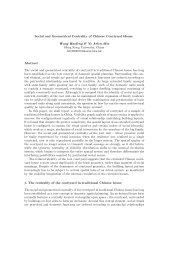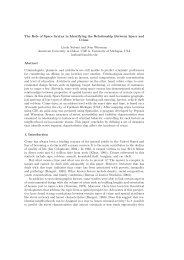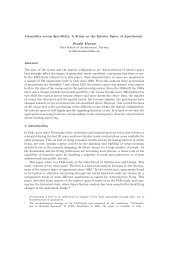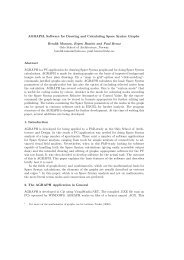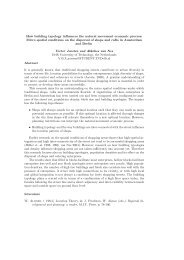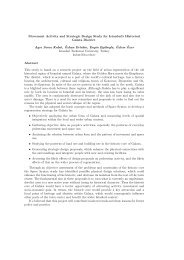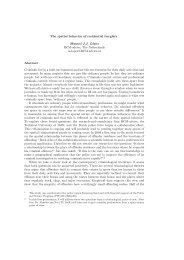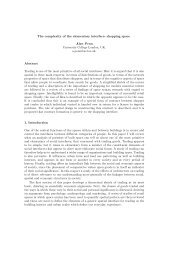High Resolution Analysis of Crime Patterns in Urban Street Networks
High Resolution Analysis of Crime Patterns in Urban Street Networks
High Resolution Analysis of Crime Patterns in Urban Street Networks
You also want an ePaper? Increase the reach of your titles
YUMPU automatically turns print PDFs into web optimized ePapers that Google loves.
<strong>High</strong> <strong>Resolution</strong> <strong>Analysis</strong> <strong>of</strong> <strong>Crime</strong> <strong>Patterns</strong> <strong>in</strong> <strong>Urban</strong> <strong>Street</strong> <strong>Networks</strong>: an <strong>in</strong>itialstatistical sketch from an ongo<strong>in</strong>g study <strong>of</strong> a London borough 47712. ConclusionOverall, we can say that urban <strong>in</strong>tegration, and the <strong>in</strong>crease <strong>in</strong> movement and levels <strong>of</strong>activity that it br<strong>in</strong>gs has a double effect; it can produce more natural surveillance andsafety <strong>in</strong> numbers and so reduce crime; and it may mean than potential crim<strong>in</strong>als also use<strong>in</strong>tegrated streets, and so make more accessible locations more dangerous. Both effectsundoubtedly exist, and a key variable is the degree to which there is a residential culture<strong>in</strong> more active areas. Where it exists, crime risk is reduced, where is does not, risk is<strong>in</strong>creased. But these benefits do not seem to pass through the <strong>in</strong>terven<strong>in</strong>g variable <strong>of</strong>community formation. They seem to be much simpler: effects <strong>of</strong> the ord<strong>in</strong>ary co-presence<strong>of</strong> people that everyday movement and activity br<strong>in</strong>gs. A residential culture, it might beconjectured, is first a culture <strong>of</strong> civilised co-presence, and only second, and after due time, aculture <strong>of</strong> community formation. This, perhaps, is what made historic cities, which alwaysbrought heterogeneous population <strong>in</strong>to dense patterns <strong>of</strong> contact, the civilised places theyseemed to be. As both Jane Jacobs and Oscar Newman observed, a society which doesnot civilise its streets cannot be civilised.The ‘other side <strong>of</strong> Newman’ the needs to be addressed by the design aga<strong>in</strong>st crimecommunity. The benefits that Newman saw <strong>in</strong> a well used network <strong>of</strong> streets l<strong>in</strong>k<strong>in</strong>gthe city together can real, and they largely depend on the presence <strong>of</strong> good numbers <strong>of</strong>dwell<strong>in</strong>gs on streets, and the fulfill<strong>in</strong>g <strong>of</strong> certa<strong>in</strong> design condition such as the siz<strong>in</strong>g <strong>of</strong>blocks, the structur<strong>in</strong>g <strong>of</strong> permeability, and ma<strong>in</strong>ta<strong>in</strong><strong>in</strong>g a high ratio <strong>of</strong> residence to nonresidencewhere uses are mixed. It has always been, and rema<strong>in</strong>s, unclear how break<strong>in</strong>g thel<strong>in</strong>k between residence and the street, as implied by the universalisation <strong>of</strong> the residentialenclave, can lead to anyth<strong>in</strong>g but an <strong>in</strong>creas<strong>in</strong>gly <strong>in</strong>secure public realm <strong>of</strong> our cities.LiteratureAlford, V. (1996) <strong>Crime</strong> and space <strong>in</strong> the Inner City, <strong>Urban</strong> Design Studies 2: 45-76.Bowers, K.J., Johnson, S.D. & Pease, K. (2004) Prospective Hotspott<strong>in</strong>g: TheFuture <strong>of</strong> <strong>Crime</strong> Mapp<strong>in</strong>g? The British Journal <strong>of</strong> Crim<strong>in</strong>ology, advance access.Hillier, B. (1988) Aga<strong>in</strong>st enclosure, Rehumanis<strong>in</strong>g Hous<strong>in</strong>g, M. T. W. T. Teymur N.London, Butterworths: 63-85.Hillier, B. (2004) Can <strong>Street</strong>s Be Made Safe? <strong>Urban</strong> Design International 9(1): 31-45.Hillier, B., Iida, S. (2005) Network effects and psychological effects: a theory <strong>of</strong> urbanmovement, This proceed<strong>in</strong>gs.Hillier, B. and Shu, S. (2000) <strong>Crime</strong> and <strong>Urban</strong> Layout: The Need for Evidence; <strong>in</strong>:Ball<strong>in</strong>tyne, S., Pease, K. and McLaren, V. Secure Foundations: Key Issues <strong>in</strong> <strong>Crime</strong>Prevention, <strong>Crime</strong> Reduction and Community Safety London, IPPR.Hillier, B. (2000) Centrality as a process: account<strong>in</strong>g for attraction <strong>in</strong>equalities <strong>in</strong> deformedgrids, <strong>in</strong>: <strong>Urban</strong> Design International 3/4, p. 107-127.Hillier, B. (1996) Cities as movement economies, <strong>in</strong>: <strong>Urban</strong> Design International, Vol.1 No. 1, p. 49-60.Hillier, B. (1999) The hidden geometry <strong>of</strong> deformed grids: or, why space syntax works,when it looks as though it shouldn’t, <strong>in</strong>: Environment and Plann<strong>in</strong>g B-Plann<strong>in</strong>g &Design, 26, no. 2:169-191.



